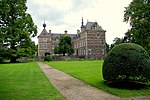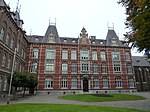Berwinne
AubelBelgium river stubsDalhemPages with Dutch IPAPages with French IPA ... and 5 more
Rivers of BelgiumRivers of Limburg (Belgium)Rivers of Liège ProvinceTributaries of the MeuseVoeren

The Berwinne (French pronunciation: [bɛʁwin]; Dutch: Berwijn, Dutch pronunciation: [bɛrˈʋɛi̯n]) is a small river in the north-eastern part of Belgium. It is a right-bank tributary to the Meuse river and flows over a distance of 31.9 kilometres (19.8 miles) through the provinces of Liège and Limburg. Its source is located in the eastern part of the municipality of Aubel, near the Henri-Chapelle American Cemetery and Memorial. From there the Berwinne river flows, generally spoken, in northwestern direction, through places like Val-Dieu Abbey, Dalhem and Moelingen, before joining the Meuse between Visé and the Dutch border.
Excerpt from the Wikipedia article Berwinne (License: CC BY-SA 3.0, Authors, Images).Berwinne
Quai du Barrage,
Geographical coordinates (GPS) Address Nearby Places Show on map
Geographical coordinates (GPS)
| Latitude | Longitude |
|---|---|
| N 50.7554 ° | E 5.6834 ° |
Address
45
Quai du Barrage
4600
Liège, Belgium
Open on Google Maps










